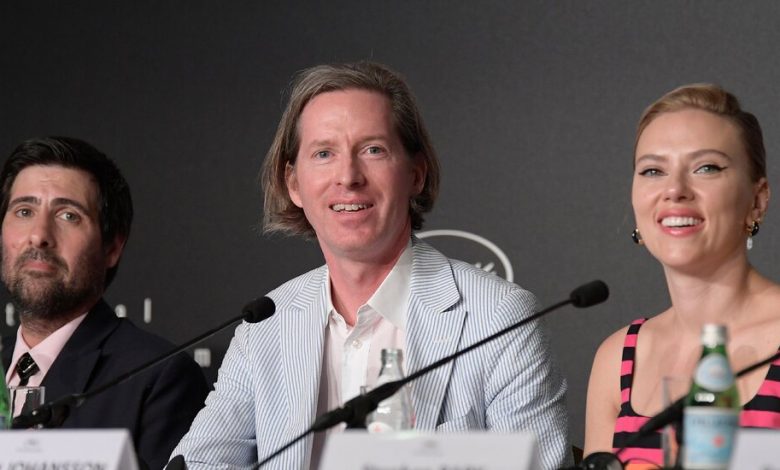Wes Anderson’s ‘Asteroid City’: How Wessy Is It?

Wes Anderson’s directorial style is so distinctive and particular — so Wessy — that it’s spawned no end of recent A.I. parodies. But how do those imitations compare with the real thing?
Many of Anderson’s signature obsessions are on display in his new movie, “Asteroid City,” a ’50s-set comedy about different sets of parents accompanying their space-obsessed kids to a convention in the desert, where they all must quarantine together after receiving an unexpected visitor from the skies. (Strained family dynamics, nerdy children and whimsical settings … check, check, check!)
Critics appeared split on the movie after its Cannes Film Festival premiere on Tuesday: though “Asteroid City” got glowing notices in The Telegraph and IndieWire, Variety deemed it “for Anderson die-hards only.” That suggests this is his Wessiest movie yet, a case that could certainly be made when you consider the following:
It’s filled with his favorite actors.
The expansive cast includes several Anderson regulars, including Jason Schwartzman as a war photographer and Tilda Swinton as a kooky astronomer, plus Jeffrey Wright, Edward Norton, Adrien Brody, Liev Schreiber and Tony Revolori. Scarlett Johansson, previously called on to do a voice in Anderson’s stop-motion “Isle of Dogs,” gets her first live-action role for the director as a self-absorbed actress who finds herself quarantined next door to Schwartzman. Only two Anderson veterans are missing: Bill Murray, who was originally cast in “Asteroid City” but reportedly had to drop out because of Covid-19, and Owen Wilson.
There are big stars in small roles.
Actors clamor to star in Anderson’s films, and he takes full advantage: Even the tiniest supporting roles are typically filled with heavy hitters (as in “The French Dispatch,” where Emmy winner Elisabeth Moss is essentially a featured extra). “Asteroid City” welcomes A-lister Tom Hanks into the fold as Schwartzman’s father-in-law, though he’s not as significant a presence as you might expect. Still, at least he’s got more to do than “Barbie” star Margot Robbie and recent Oscar nominee Hong Chau, who each pop in for the briefest of cameos. In future Anderson films, maybe they’ll be upgraded to the main ensemble.
It’s got a complicated framing device.
Anderson’s films often call attention to their own storytelling by nesting the narrative within another narrative: Perhaps it’s all taking place in a book, or the vignettes are stories in a magazine. In “Asteroid City,” the director indulges in his most complicated construction yet: We’re meant to be watching a TV broadcast (hosted by Bryan Cranston) that dramatizes the story of a playwright (Norton) who wrote an unproduced stage production called “Asteroid City.” Those framing segments are shot in black and white. It’s only when we leap into the idea of his play that Anderson transports us to the gorgeous teals and burnt oranges of the desert, where most of this story within a story (within a story!) unfolds.
It all takes place on rigid lines.
Though Anderson has become less fixated on placing his actors in the smack-dab middle of the frame, he still blocks his camera movements and choreography in “Asteroid City” so that everything and everybody moves on an x or y axis at all times. (If you want to sneak up on someone in a Wes Anderson movie, do it diagonally. They’d never think to look!)
There are deadpan expressions of grief.
Schwartzman’s war photographer has something he’s meaning to tell his children: Their mother has died. Or, more specifically, their mother died three weeks ago and he just hasn’t found the right moment to bring it up. The situation is outrageous, but Schwartzman’s performance is classic Wes deadpan, and though most of the cast members give the same steady line readings, that house style is at its best when you can sense real, troubled currents underneath a placid exterior.
But it could have been even Wessier …
If, after reading all this, you think “Asteroid City” couldn’t get more Wessy … well, it could! At the film’s Cannes news conference on Wednesday, the actor Steve Park said that before shooting began, Anderson created a feature-length, animated storyboard, or animatic, in which he did all the voices himself. “Release the animatics,” Jeffrey Wright intoned solemnly.
… especially if it used slow-motion.
Later in the news conference, a reporter confronted Anderson about one trademark that’s disappeared: Though he used to use slow-motion sequences fairly often — think Gwyneth Paltrow dramatically exiting her bus in “The Royal Tenenbaums” — recent films like “Asteroid City” have all but dropped the device. “I have a series of ways I like to stage things and I don’t know if I’m in command of them — it’s part of my personality,” Anderson said, before growing concerned. “That’s one of the tools that I’ve used often, and I should look for some spots for that,” he promised the reporter. “I’ll take the note. And I’ll do it!”



